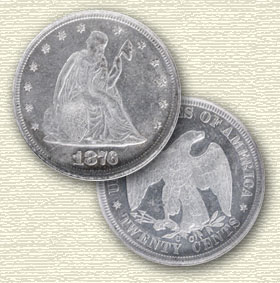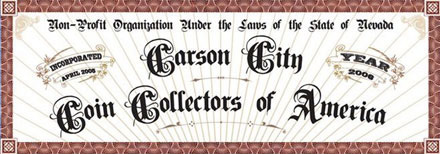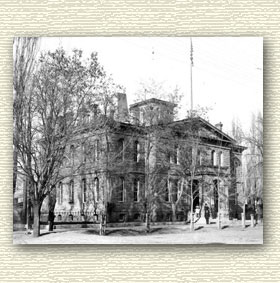- Posts: 499
- Thank you received: 0
The Summer 2011 Chronicle is in the Mail!
14 years 6 months ago - 14 years 6 months ago #2687
by Belayoff
C4OA Lifer!
Replied by Belayoff on topic Re:The Summer 2011 Chronicle is in the Mail!
Received my new Curry's but have not had a chance to read all of the articles yet.
However, I started by reading Rusty's article on the (new?) Eagle variety. As Rusty knows, my own example of the 1892-CC Eagle includes the tripling as well.
Thanks Rusty for the refresher on the various ways that varieties occur. It was very instructive.
I thought it was interesting that you referred to the 1876-CC 20c, with its heavy obverse doubling, as a variety. If all 1876-CC 20 centers are so doubled, would it still be referred to as a variety for the year, or would it simply be a variety for the series?
Belay Off
However, I started by reading Rusty's article on the (new?) Eagle variety. As Rusty knows, my own example of the 1892-CC Eagle includes the tripling as well.
Thanks Rusty for the refresher on the various ways that varieties occur. It was very instructive.
I thought it was interesting that you referred to the 1876-CC 20c, with its heavy obverse doubling, as a variety. If all 1876-CC 20 centers are so doubled, would it still be referred to as a variety for the year, or would it simply be a variety for the series?
Belay Off
C4OA Lifer!
Last edit: 14 years 6 months ago by Belayoff.
Please Log in to join the conversation.
14 years 6 months ago #2693
by mitchell
C4OA Lifer!
Replied by mitchell on topic Mine arrived on 6/9
My copy showed up yesterday, safe and sound.
Thanks everyone at Southgate for making it happen.
Mitchell
ps: haven't had time to read it but it looks good.
Thanks everyone at Southgate for making it happen.
Mitchell
ps: haven't had time to read it but it looks good.
C4OA Lifer!
Please Log in to join the conversation.
14 years 6 months ago - 14 years 6 months ago #2694
by Carsonite
C4OA Lifer!
Replied by Carsonite on topic Re:The Summer 2011 Chronicle is in the Mail!
Belay Off,
I’m glad you enjoyed my article.
You wrote:
Similarly, Breen and other numismatic writers, including Doug Winter, use the expression, “only one variety known,” which technically might be unnecessary, but shows the broader use of the term variety. See, for example, in Doug Winter’s “CC” gold coin book the listing for 1878-CC $10 gold pieces. He says there is just one die variety known for this date.
In Breen’s encyclopedia glossary, he defines variety as follows: “Any coin recognizably different in dies from another of the same design, type, date, and mint.” Another definition of variety (non-numismatic) is, “A category of things distinguished by some common characteristic or quality.”
Other words we could substitute for the word variety are type, sort, kind, species, strain, form of, style, and peculiarity.
In my Curry’s article, when I include the 1876-CC twenty-cent piece in my discussion of “CC” Coins and Varieties, I use the term variety in the broadest sense. Examples of this classic rarity are recognizably different from the intended design the chief designer submitted, and probably what appeared on the master hub. The changed elements (i.e. the doubling, raised die lines, etc.) differed from the original design.
Breen even calls the 1876-CC twenty-cent piece a DOUBLE LIBERTY, in effect christening it as a variety without actually using the term “variety.” He claims that only one set of dies was used (out of the six obverse and four reverse dies shipped to Carson City) to strike the 1876-CC twenty-cent pieces. This we don’t know for sure, since nearly 99.8% of the original mintage was melted, and we don’t have the Carson Mint’s coiner or superintendent reports to verify when the 10,000 pieces were struck, and if it happened in one or multiple days. (It is possible that non-Double LIBERTY pieces were struck, although we’ll probably never know.)
Perhaps the Carson Mint did strike non-Double LIBERTY 1876-CC twenty-cent pieces. Because of this date’s rarity, no one has ever produced a study on different varieties of the 18 – 19 pieces known. When I owned three examples of this date at the same time, I saw subtle differences in characteristics that an analytical person could have made a case for putting them in sub-variety categories—although the major diagnostic on all three was the Double LIBERTY.
When I wrote in my Curry’s article, “The most striking display of diagnostics on a Carson City coin is seen on all known examples (18 or 19) of the 1876-CC twenty-cent piece,” I wanted to interject this special coin’s incredible characteristics to the discussion on anomalies in the “CC” coin series. To avoid confusion, perhaps I should have titled this section, “’CC’ Coins and Diagnostic Anomalies.”
So when you ask, “Would it still be referred to as a variety for the year, or would it simply be a variety for the series?” The answers are “Yes and No, depending on whose definition of variety we are referring to: It could, in the spirit of Breen, Winter, and Bugert, be classified as ‘The only known variety for the date.’” and “Definitely Yes—The coin is too special not to give it recognition.”
And I might add, we can certainly call it a variety in terms of it being a variation of the norm when compared to the original design as submitted by the designer, and as it probably appeared on the working hub.
I hope these comments answer your questions.
Rusty
I’m glad you enjoyed my article.
You wrote:
Variety is a generic term; it can be used to describe many concepts. In the strictest numismatic sense, when Bill Bugert, for instance, is talking about variety attributions he is referring to different die marriages for different dates in the Seated half dollar series. For him, the terms “die marriage” and “variety” are synonymous. So when he says only one die marriage is known for the 1878-CC half dollar, he means there is only one variety for this date. He is not saying this variety is unusual or fits into the error-coin category.I thought it was interesting that you referred to the 1876-CC 20c, with its heavy obverse doubling, as a variety. If all 1876-CC 20 centers are so doubled, would it still be referred to as a variety for the year, or would it simply be a variety for the series?
Similarly, Breen and other numismatic writers, including Doug Winter, use the expression, “only one variety known,” which technically might be unnecessary, but shows the broader use of the term variety. See, for example, in Doug Winter’s “CC” gold coin book the listing for 1878-CC $10 gold pieces. He says there is just one die variety known for this date.
In Breen’s encyclopedia glossary, he defines variety as follows: “Any coin recognizably different in dies from another of the same design, type, date, and mint.” Another definition of variety (non-numismatic) is, “A category of things distinguished by some common characteristic or quality.”
Other words we could substitute for the word variety are type, sort, kind, species, strain, form of, style, and peculiarity.
In my Curry’s article, when I include the 1876-CC twenty-cent piece in my discussion of “CC” Coins and Varieties, I use the term variety in the broadest sense. Examples of this classic rarity are recognizably different from the intended design the chief designer submitted, and probably what appeared on the master hub. The changed elements (i.e. the doubling, raised die lines, etc.) differed from the original design.
Breen even calls the 1876-CC twenty-cent piece a DOUBLE LIBERTY, in effect christening it as a variety without actually using the term “variety.” He claims that only one set of dies was used (out of the six obverse and four reverse dies shipped to Carson City) to strike the 1876-CC twenty-cent pieces. This we don’t know for sure, since nearly 99.8% of the original mintage was melted, and we don’t have the Carson Mint’s coiner or superintendent reports to verify when the 10,000 pieces were struck, and if it happened in one or multiple days. (It is possible that non-Double LIBERTY pieces were struck, although we’ll probably never know.)
Perhaps the Carson Mint did strike non-Double LIBERTY 1876-CC twenty-cent pieces. Because of this date’s rarity, no one has ever produced a study on different varieties of the 18 – 19 pieces known. When I owned three examples of this date at the same time, I saw subtle differences in characteristics that an analytical person could have made a case for putting them in sub-variety categories—although the major diagnostic on all three was the Double LIBERTY.
When I wrote in my Curry’s article, “The most striking display of diagnostics on a Carson City coin is seen on all known examples (18 or 19) of the 1876-CC twenty-cent piece,” I wanted to interject this special coin’s incredible characteristics to the discussion on anomalies in the “CC” coin series. To avoid confusion, perhaps I should have titled this section, “’CC’ Coins and Diagnostic Anomalies.”
So when you ask, “Would it still be referred to as a variety for the year, or would it simply be a variety for the series?” The answers are “Yes and No, depending on whose definition of variety we are referring to: It could, in the spirit of Breen, Winter, and Bugert, be classified as ‘The only known variety for the date.’” and “Definitely Yes—The coin is too special not to give it recognition.”
And I might add, we can certainly call it a variety in terms of it being a variation of the norm when compared to the original design as submitted by the designer, and as it probably appeared on the working hub.
I hope these comments answer your questions.
Rusty
C4OA Lifer!
Last edit: 14 years 6 months ago by Carsonite. Reason: Typos
Please Log in to join the conversation.
- mcfly65202
- Offline
- Junior Member
-

Less
More
- Posts: 35
- Thank you received: 0
14 years 6 months ago #2695
by mcfly65202
Replied by mcfly65202 on topic Re:The Summer 2011 Chronicle is in the Mail!
Carsonite,
This is definitely an interesting insight. When you consider the broad use of "variety," a real strict diagnostics geek could start interjecting any alteration or "touch ups" on a working die or working hub a separate "variety." A guy could call die or hub lapping, recutting, etc. a different "variety." Of course, to that extreme, I would say that "the guy really needs to get out more".
I hadn't really thought that much about the different aspects of what a "variety" really entails. And, this from a guy who also collects Capped Bust Halves with it's 450 something Overton classifications.
Thanks for engaging my thought processes.
You too BelayOff
mcfly
This is definitely an interesting insight. When you consider the broad use of "variety," a real strict diagnostics geek could start interjecting any alteration or "touch ups" on a working die or working hub a separate "variety." A guy could call die or hub lapping, recutting, etc. a different "variety." Of course, to that extreme, I would say that "the guy really needs to get out more".
I hadn't really thought that much about the different aspects of what a "variety" really entails. And, this from a guy who also collects Capped Bust Halves with it's 450 something Overton classifications.
Thanks for engaging my thought processes.
You too BelayOff
mcfly
Please Log in to join the conversation.
14 years 6 months ago #2696
by VeganDave
Replied by VeganDave on topic Re:The Summer 2011 Chronicle is in the Mail!
First post, WOO HOO! my copy came in last week Saturday and i read it from cover to cover. very enjoyable reading.
Please Log in to join the conversation.
Time to create page: 0.198 seconds


